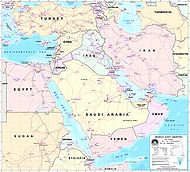Permeable state borders have been both a contributor to, and a consequence of, the current upheavals in the Middle East. The free flow of fighters, weapons, and illicit money across the poorly policed frontiers of the region has emboldened the Islamic State and other militant groups, aiding insurgent campaigns in Libya, Egypt, Syria, Iraq, and Lebanon. In response, authorities in these states are taking increasingly drastic measures to fortify their borders and impose order.
Tunisia has established buffer zones to stem spillover from a rapidly disintegrating Libya. Two weeks ago, in the Sinai town of Rafah, the Egyptian government evacuated over 1,000 residents and demolished their homes in an attempt to curb the influx of arms and militants from Gaza, which Cairo claims has contributed to a series of sophisticated attacks against local police and military outposts orchestrated by Ansar Beit al-Maqdis, a ruthless band of Egyptian rebels. And Turkey has pursued a series of strategies to reinforce its porous border with Syria, calling most recently for a cross-border militarized zone to help combat the encroaching Islamic State.
It is difficult to fault states for attempting to shield their territories from security threats. But the international community should be concerned about the humanitarian impact of these buffer zones, which have significant implications for the tens of thousands of civilians uprooted by violence in Libya and the 13.6 million displaced by the conflicts in Syria and Iraq. Militarizing borders and restricting access can interfere with individuals’ right to seek asylum and protection under the UN Refugee Convention. Many Syrians and Iraqis have been denied entry into Jordan, Turkey, and Iraqi Kurdistan. Since a bulk of the uprooted are internally displaced, they are particularly vulnerable to persecution and deprivation, yet that much more difficult to reach for humanitarian agencies — a growing concern as winter approaches.
Moreover, some of the heavy-handed tactics these countries are using to secure their borders may entail gross violations of international law. Egypt’s operation in Sinai is particularly disturbing, as the displacement of local populations has become an objective, not simply a byproduct, of military action. With the potential to render 10,000 civilians homeless and dislodged from their communities, the operation defies humanitarian and human rights law, in addition to the Kampala Convention on Internal Displacement. While the UN was quick to condemn the rebel attacks that elicited Egypt’s military response, it remains silent on the conduct of the government’s counterinsurgency. Similar to other instances where such strategies have been employed, Egypt’s gambit does not appear to be working.
Part of the problem is that the motivations behind these measures are unclear. While ostensibly aimed at repelling cross-border threats, efforts to establish buffer zones in Egypt and Turkey may also be intended to quell internal dissent and neutralize restive communities. It is puzzling that Egyptian authorities have not undertaken similar measures along the country’s western border with Libya, which has hemorrhaged a far greater number of weapons and combatantsthan Gaza. Critics of the Turkish government allege that its plans for a cross-border buffer are a thinly veiled attempt to smother residents of the autonomous Kurdish region in Syria, who are linked to the PKK, a rebel group that has waged a secessionist campaign against Turkey for decades. Whether or not this claim has any credence, it indicates that policies justified under the auspices of introducing stability may, in fact, foment instability — which should subject them to greater international scrutiny.
